Abstract
This research presents an optimal scheme for the integration of renewable resources with the utility grid to minimize the operational cost of the residential and industrial microgrids. With the changing paradigm of solar photovoltaic in low-voltage distribution networks, utilities have allowed net metering and feed-in tariff (FiT). These incentives encourage residential and industrial consumers to contribute toward energy generation. However, in conventional mode, the system may underperform if resources are not scheduled optimally. To compensate for the price difference during off-peak and on-peak hours, the energy should be taken from the grid when electricity prices are lower and supplied to the grid when the electricity price is higher. The proposed models will therefore allow optimal resource utilization considering intermittent renewable generation as well as a time-varying utility tariff. A complete comparative analysis of on-grid and off-grid models was carried out. The results indicate that the daily average saving is about 32.0% by using the proposed on-grid scheme, where a feed-in tariff is available.
1. Introduction
According to the World Economic Forum (WEF), residential and commercial buildings are responsible for 40% of global energy consumption and 33% of greenhouse gas (GHG) emissions [1]. Energy management systems (EMSs) provide an excellent interface to achieve energy efficiency as well as reduce GHG emissions by integrating green and environmentally friendly on-site renewable power generation. In recent years, home energy management systems (HEMSs) have become significant due to increased focus on efficient electricity consumption and increasing global warming [2].
HEMSs are used to monitor and manage the house load power by communicating with utilities and appliances. HEMSs receive information on tariff rates and schedule the utilization of batteries during on-peak hours to reduce the electricity cost. Different techniques as discussed in the literature review section (Section 2) are available to overcome this issue; however, in this research, linear programming (LP) was used to achieve the optimization target. LP offers simplicity in implementation and also allows for managing the preset priority values of battery utilization and ensures the total consumption of batteries within defined limits. While designing such a framework, many constraints are considered keeping in view the user comfort, cost-effectiveness, and feed-in tariff (FiT). It is a scheme based on real-time optimal scheduling in which residential load, battery profile, solar output, and tariff rates are monitored and considered for optimization. For battery charging and discharging, constraints are defined to make its life cycle efficient.
The structure of the paper is as follows. Section 2 is dedicated to carrying out a brief literature review and focused on the scope of EMSs with different techniques. Section 3 deals with the mathematical formation of proposed models in which different types of variables and constraints are defined to make an easy and comprehensive optimization model. One-day case studies are conducted to evaluate the results, and later on, a monthly basis analysis is carried out. In Section 4, results and discussion are presented to conclude the outcomes of the proposed models. Section 5 covers the conclusions of the overall research study.
2. Literature Review
In [3], the demand response (DR) technique was used for the EMS, which was further classified by the author into three types of automation levels: (a) manual; (b) semi-automated; (c) fully automatic. Meanwhile, the HEMS uses fully automatic DR for load scheduling and shifting. An algorithm was presented for managing home appliances and was also designed as a simulation tool to simulate events. Power consumption was kept below the limit by using the DR, and the HEMS algorithm and load preference were adjusted according to the comfort level. However, if the load demand is less than a specific value, there would be some sacrifice in accordance, and rules may break down; therefore, there is compromise taken into account while setting parameters. Moreover, it might be possible that a DR event could generate a high off-peak demand due to compensation of load which is the limitation of the DR technique.
In [4], a scheme based on real-time optimal scheduling was discussed, in which house loads, outdoor temperature, and tariff rates are monitored and considered for optimization. It efficiently calculates the best readings based on deep reinforcement learning (DRL), whereas traditional algorithms need preset values and cannot handle the uncertainties compromising user comfort. Coordinated scheduling including the day-ahead method was proposed in [5] through the distribution of available energy resources known as distributed energy resources (DER) in which the particle swarm optimization (PSO) technique was utilized to overcome the issues discussed in [4]. However, their scheduling was not supposed to design uncertainties in load demands and accordance, with the joint scheme based on the building energy management system (BEMS) and home energy management system (HEMS) proposed by the author. The Korea Electric Cooperation (KEPCO) tariff was employed via using a sequential management policy of prediction, and as a result, minimum energy cost can be extracted under given restriction. The proposed method is more efficient and adaptive for interruptible loads than the day-ahead method. A numerical analysis of installed appliances was performed by the author seeking a model in terms of the availability of solar energy and improving its charging efficiency. Here, the limitation was the usage of appliances according to their respective plans [5,6].
All results were compared in [7] which concluded the best outcomes of the proposed scheme because the uncontrolled scheme has no controlling factor that reflects the desire of the user, whereas in the load curtailment method, more energy is utilized than in the token-budget-scheme-based algorithm.
Microgrid (MG) offers the advantages of independent and self-sustainable connectivity between the main grid and DER while ensuring the efficient usage of renewable energy resources (RESs). Therefore, the inter coordination of such systems and practical implementation within MG imply several challenges due to uncertainties and variability [8]. In [9], an online MG-EMS was proposed which is composed of four modules: The first one is a data acquisition and human–machine interface module (DAQ & HMI) through which the user can monitor and alter the input parameters. Second, scheduling the inputs by taking input data from other modules is fed to the processor module. The third module is the forecasting module which collects the records of the generation and consumption of energy for future prediction values. Finally, the optimization process sets the parameters as defined by the user and keeps the objective function in consideration. All these four modules intercommunicate to discover the optimum results, and a case study was presented by the authors to extract the real-time results of the island and grid-connected modes of operation [9].
In [10], the author suggested a probabilistic optimization of networked multi-carrier microgrids (NMCMGs), elaborating on the unpredictability associated with thermal and electrical load demands, renewable power generation, and the electricity mark. Moreover, the authors also covered the redundancy scheme in the absence of the main grid. Extensive research work has been testified linked to the managing of MGs, principally focused on mathematical modeling and tested under determined offline case studies, as studied in [11]. For illustration, in [12], linear mathematical modeling was proposed to stabilize the generation and load of a hybrid MG by curtailing the entire operational cost of the system in 24 h. A control combined fuzzy logic control with advanced scheduling methods to achieve both power-sharing and energy management [13]. Meanwhile, in [14], the economic dispatch challenge for entire operational cost minimization in DC MGs was expressed and explained with an empirical method. However, these methods do not extend in the strategy of the MG-EMS architecture so that it can be adjustable and simply combined into the system. In this concern, a system of smart energy management was defined in [15,16] with an architecture that practices changed modules that are linked serially, but this can crop a block in the data flow. Moreover, the preceding mechanism is not concerned with the doubt about the generation and utilization of renewable sources. In this logic, connected strategies were applied in [17,18,19,20,21,22], where MG-EMSs were intended and applied by observing the present position of the MG.
Hybrid AC/DC microgrids and implementing the power management schemes were discussed with different modes of operation in [23]. Thus, the EMS of the MG generates the reference command for DER controllers to run the whole system in an optimized way. For this purpose, the MG-EMS takes short-term decisions that utilize input parameters and available resources profile to meet the load uncertainties [24].
In [25], the HEMCS consisted of a smart meter, electric appliances, GUI, and an energy management control unit (EMCU). The EMCU collects information on pricing through a smart meter and can use different protocols of communication such as ZigBee, Wi-Fi, etc. In this method, appliances are classified according to the consumption pattern and connectivity method with the EMCU. The aim to provide green energy needs an efficient model established for the configuration and integration of RESs on a large scale to facilitate the neighboring consumers to generate revenue in the result.
Based on energy trading with RESs, the residential consumers are further categorized into three types. (1) GECs get energy only from the grid and neither generate the energy nor sell it back; (2) SECs generate their own energy and incorporate the electricity demand of neighbors; and (3) TECs generate, store, and trade energy with neighboring customers. The formulation is performed on respective categorized consumers, and equations are developed to design their models. Generally, it is a difficult scope to formulate joint optimization of RESs and load scheduling; therefore, it is formulated individually. The knapsack approach is utilized for load scheduling problems. It is essentially used to map multiple problems in multiple domains. Here, mapping objectives were electricity cost and user comfort, and an objective function was derived [26].
A multi-agent control system (MACS) was proposed in [27] to meet the user’s comfort zone and consider cost-effectiveness. A graphical user interface (GUI) was also developed to facilitate the user to alter the preferences according to the demand. However, many issues such as appliance waiting time, PAR, and smoothness of the demand curve were not discussed. The cost model and the trading problem were also formulated in which users according to their respective categories were presented. Feasible regions of electric cost and consumption were derived. When the waiting time is zero, then the cost of electricity is high; therefore, in this case, these parameters were inversely proportional, and its feasibility region was extracted. Specifically, a peak power consumption analysis was carried out by comparing with the daily usage of appliances. A trade-off analysis of electricity cost and user comfort was also graphed. It was mentioned that reverse power consumption is lower when distributing the energy to neighboring consumers than when supplying it to the grid.
All of the abovementioned schemes are applicable where an FiT is already introduced in developed countries. However, these schemes are not suitable for developing countries where an FiT is not available. In that case, the main concern is to minimize grid supply and its utilization during on-peak hours for cost-effective operation. In this paper, an objective function is formulated in which the basic aim is to reduce grid intake, utilize off-peak hours for ESS charging and maximize utilization of RESs during the daytime, and potentially utilizing this energy during peak hours when the electricity price is high [28].
Every EMS model designed is supposed to provide lower operational costs, and different aspects have been addressed to make the EMS a more redundant, efficient, and proactive system. Nevertheless, making the existing system not compromise user comfort along with cost-effectiveness has not been properly addressed. Specifically, a universal model has not been designed that specifically fits both FiT and conventional grid utilization. Further comparison with the existing state-of-the-art works is carried out in Table 1.

Table 1.
Comparison with state-of-the-art works.
To sum up, the main contributions of the study can be stated as follows:
- The proposed scheme allows cost-effective and optimal resource utilization considering intermittent renewable generation as well as a time-varying utility tariff.
- Both types of configurations, i.e., off-grid- and on-grid-based models, were designed for HEMSs and BEMSs as universal models that fit conventional grid utilization and FiT, respectively. Both handle the situation smartly with the best optimization scheduling.
- The results were extracted through MATLAB 2021a which indicates daily average saving is about 32.0% by using the on-grid proposed scheme where a feed-in tariff is available.
3. Proposed Models
The energy management system (EMS) is directly connected to the load that decides the path and capacity, which will be fed through designated sources such as the grid, battery, or solar in an optimum way. The basic principle here is to minimize the grid cost and utilization of the battery keeping its health factor to be maintained efficiently by using a linear programming scheme (LPS). It is worth mentioning that the parameters considered for the case studies and constraints are generic and equally valid in residential, commercial, and industrial buildings except for the capacity of generation and load demand. Nevertheless, the complex industrial microgrids may offer additional parameters and constraints; however, for simplification, only the baseline parameters were covered within the scope of this study. The utilization of maximum generated power by solar was the core aim to reduce grid consumption that will ultimately result from the cost of the grid. For this purpose, two models were designed for cost analysis, i.e., off-grid and on-grid.
3.1. Off-Grid Unidirectional Model
The energy produced by solar PVs is utilized to run the load demand via the MPPT controller and does not contribute to energy selling back to the grid as shown in Figure 1. This type of model is adequate where net metering is not available and optimized utilization of produced energy needs to be panned out. For this purpose, a one-day model of an hourly based scheme was implemented to check the results of the proposed off-grid model.

Figure 1.
Off-grid unidirectional model.
3.1.1. One-Day Case Modeling
For one-day modeling and analysis, we used values on an hourly basis of a day. In this way, 24 values per day were considered for each parameter and decision variable. We defined 24 h load and solar generation data for the model and placed them in variables (at) and (st), respectively. For the battery’s efficient usage and to enhance its life, we applied an algorithm in which 10% of the charging and the discharging rate is allowable in any hour interval. In these charging and discharging cycles, the battery will smoothly charge and discharge rather than getting a sudden charge or drain which affects the battery life. The permissible minimum discharging of battery is 33.3% of total capacity.
In this model, the grid is offering two price rates in a day by distinguishing between off-peak and peak schedules. As our objective was to minimize the cost of the grid but not compromise the user load demand, the EMS will proficiently optimize and opt for the source that will directly impact our objective function. As follows, a one-day model will conclusively provide the cost of the grid per day. The following Table 2 of pricing is given.

Table 2.
Off-grid pricing.
Thus the objective function with minimized grid intake can result in a benefit to the end-user of the microgrid.
where grid utilization for load is demand, and is grid usage for battery charging purposes. Pricing of the grid as per off-peak and on-peak is denoted by . The following inequality constraints are considered:
where T = 24 is considered for the case study; all the constraints clearly define that grid to load value will be greater than zero but not in the negative direction, and in the same arrangement,, , , and will be greater than zero at any time instant. Meanwhile, in the (8) inequality constraint, the total energy fed by the grid to load and the battery would be less than the total available grid at any instant. In addition, the battery SoC at any instant cannot exceed the maximum allowable energy stored in the battery by (9), and in the same fashion, the battery cannot drain less than the allowable limit set as (10). The most accountable and foremost important constraint is of maintaining battery health that will strictly monitor the way the battery is charging and discharging. There is a limitation for battery charging and discharging that 10% of the maximum capacity of battery charging and discharging is allowed in the constraints (11) and (12).
Equality constraints considered for this optimization model are given below:
Equality constraint (13) indicates that load at any instant must be fed through the grid, solar, or battery. Meanwhile, the battery-related equality constraint indicates the next state of the battery at any instant (14). In addition, solar PV generation at any moment either will be fed to load or battery (15). The (16) and (17) equality constraints define the initial and final SoC of the battery.
3.1.2. Decision Variables Set
The optimizer will provide values of decision variables and decide the amount of grid, battery, and solar needed to utilize according to the load requirement. These values of each decision variable are extracted by the EMS model through MATLAB. The decision variable set of the objective function is defined as:
3.2. On-Grid Bidirectional Model
The energy produced by solar PVs is utilized to run the load demand via the MPPT controller and contributes to energy selling back to the grid. This type of model is adequate where a feed-in tariff (FiT) is available and optimized utilization of produced energy needs to be carried out. For this purpose, a one-day model of an hourly based scheme was implemented to check the results of the proposed on-grid model.
3.2.1. One-Day Case Modeling
In this model, the same parameters and decision variables as in off-grid modeling are kept with the addition of energy selling back to the grid. This specific variable battery to the grid is denoted as which indicates that extra optimization-based energy will be sold back to the grid. The amount of sold energy will be subtracted from the cost of energy being charged by the grid which will ultimately support the objective function of the grid cost reduction. The offered prices from the grid to customers are given in Table 3:

Table 3.
On-grid pricing.
The schematic layout in Figure 2 consists of a grid-connected solar PV-based energy management system (EMS). Solar-produced energy is kept stored in the battery which is converted to AC power using a highly efficient inverter. The grid connection is bidirectional for purchase and selling purposes. All sources are fed to the EMS which decides at which time the path will be utilized to fulfill the load demand and at which time battery charging and discharging will be carried out keeping in view the objective function. The overall net cost of purchased and sold energy is formulated with a one-day model. A day is divided into T times according to an hourly basis. Therefore, 24 values of each decision variable are provided except for the battery. The battery’s initial state of charge at t = 0 is the initial state of charge (SoC) which is denoted as eINI, whereas t = T + 1 will be the final state of the battery which will be the 25th value in this case. Thus, the objective function with minimized grid intake can result in a benefit to the end-user of the microgrid.
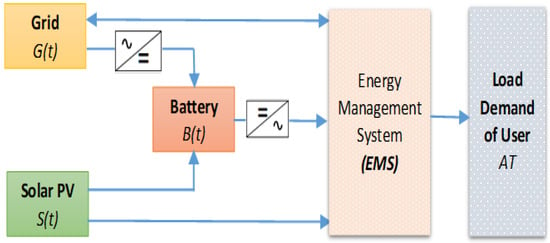
Figure 2.
On−grid bidirectional model.
Here, is the unit price charged by the grid, and is the unit price offered by the grid. As the government has given an incentive to the residential user to increase solar generation and utilization to make the environment clean, the energy sold to the grid will be subtracted from the energy purchased from the grid.
The following inequality constraints are considered:
where T = 24 is considered for the case studies; all the constraints defined as grid to load value will be greater than zero but not in the negative direction, and in the same fashion,,,, and will be greater than zero just like in the off-grid case. The only difference here is the addition of selling back to grid constraint which is. Meanwhile, in the (27) inequality constraint, the total energy fed by the grid to load and the battery would be less than the total available grid at any instant. In addition, the battery SoC at any instant cannot exceed the maximum allowable energy stored in the battery by (28), and in the same fashion, the battery cannot drain less than the allowable limit set as (29). The most accountable constraint is for maintaining battery health that will strictly monitor the way of battery charging and discharging. Sudden charge and discharge of the battery directly affect the life of the battery. There is a limitation for battery charging and discharging that 10% of the maximum capacity of battery charging and discharging is allowed in the constraints (30) and (31). Equality constraints considered for this optimization model are given:
Equality constraint (32) shows that load at any instant must be fed through the grid, solar, or battery. Meanwhile, the battery-related equality constraint (33) indicates the next state of the battery at any instant. In addition, solar PV generation S(t) at any moment either will be fed to load or to the battery (34). The (35) and (36) equality constraints define the initial and final SoC of the battery.
3.2.2. Decision Variables Set
The optimizer will provide values of decision variables and decide the amount of grid, battery, and solar needed to utilize according to the load requirement and how much is needed to sell back to the grid at a certain time. The decision variable set of the objective function is defined as:
4. Results and Discussion
4.1. Off-Grid Model One-Day Case Study
In the off-grid model, there is a unidirectional energy transfer from the grid. The energy produced by solar PVs will be utilized to fulfill the load demand. Grid costing is based on off-peak and on-peak timing. Batteries are charged via solar and grid as per energy saving and optimization techniques. The optimizer will utilize batteries during on-peak timing to reduce the grid electricity bill and recharge through solar PV and grid in off-peak timing. The off-grid model was modeled in MATLAB, and graphical results were extracted from each decision variable. The grid utilization with respect to each hour of a day is presented in Figure 3. The battery is consumed for load fulfillment shown in Figure 4 during on-peak hours when grid cost is high as mentioned in Table 1. Battery states of charge (SoCs) of each hour are shown in Figure 5. SoC scaling factor (x/10) is used, i.e., 20 = 2 KW. Solar utilization for load requirement and total solar generation with utilization as per the EMS optimizer schedule are shown in Figure 6.
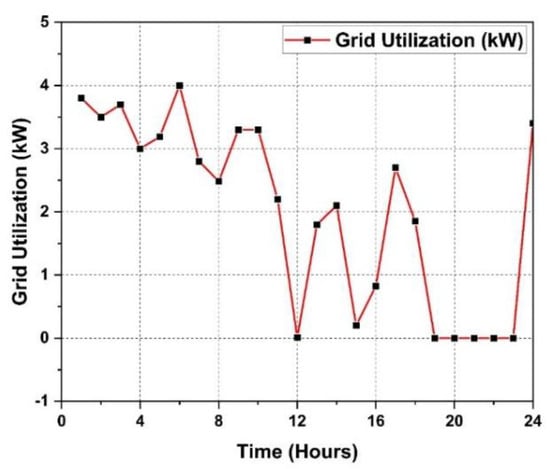
Figure 3.
Grid utilization to load (off−grid).
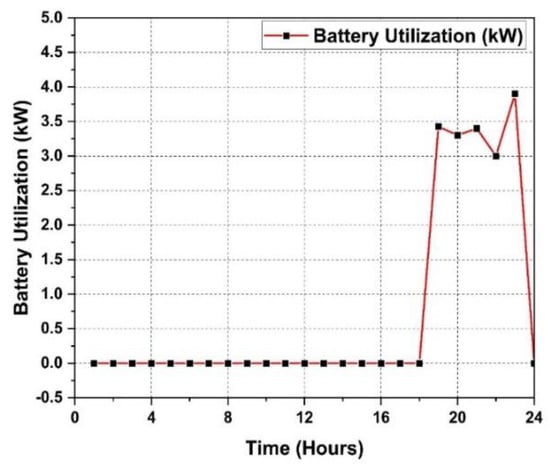
Figure 4.
Battery utilization to load (off−grid).
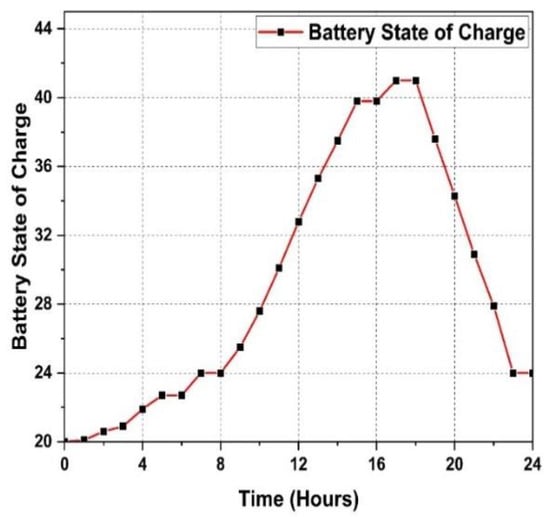
Figure 5.
Battery states of charge (SoCs) in off−grid.
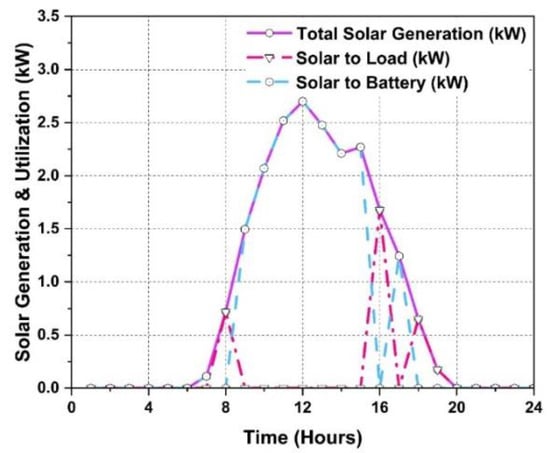
Figure 6.
Solar total generation and utilization (off−grid).
Load is directly fed through the EMS which decides the source path which needs to be triggered for the fulfillment of the load demand. A detailed analysis of total load and resource utilization in every hour is shown in Figure 7 for the off-grid model.
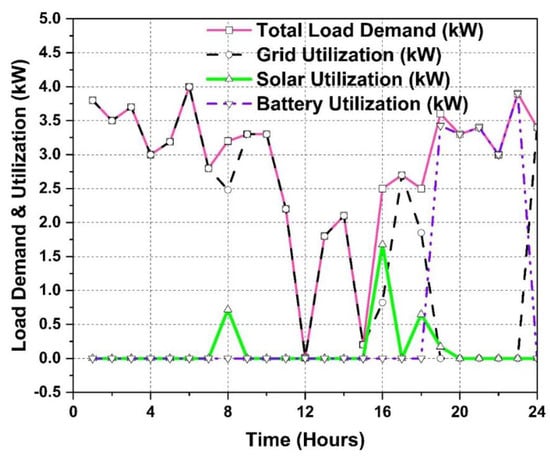
Figure 7.
Load demand and resource utilization (off−grid).
4.2. On-Grid Model One-Day Case Study
In the on-grid model, there is a bidirectional energy transfer from the grid. The energy produced by solar PVs will be utilized to fulfill the load demand along with selling back to the grid via batteries. Grid costing is based on off-peak and on-peak timing. Batteries are charged via solar and grid as per energy saving and optimization techniques as in the off-grid model. The grid utilization with respect to each hour of a day is presented in Figure 8. During on-peak timing, the battery is maximally utilized to sell back energy to the grid keeping in view the overall reduction in grid cost. The battery utilization profile is shown in Figure 9. Battery states of charge (SoCs) of each hour are shown in Figure 10. SoC scaling factor (x/10) is used as in the off-grid model, i.e., 20 = 2 KW. Solar utilization for load requirement and total solar generation with utilization as per the EMS optimizer schedule are shown in Figure 11.
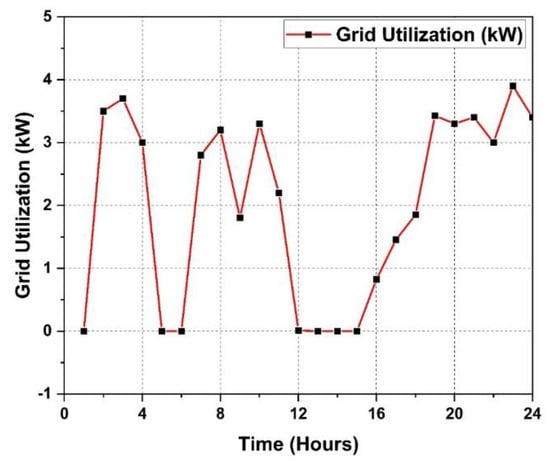
Figure 8.
Grid utilization to load (on−grid).

Figure 9.
Battery utilization profile (on−grid).
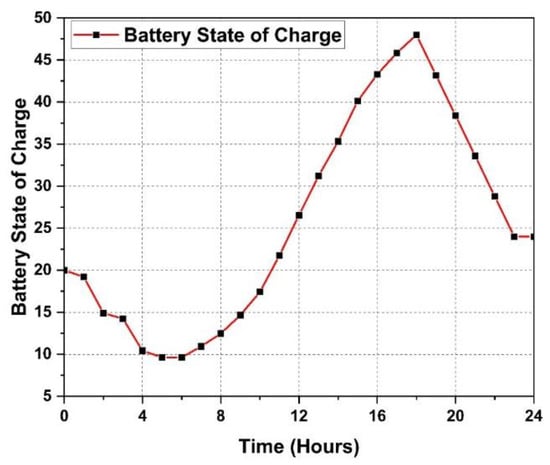
Figure 10.
Battery states of charge (SoCs) in on−grid.
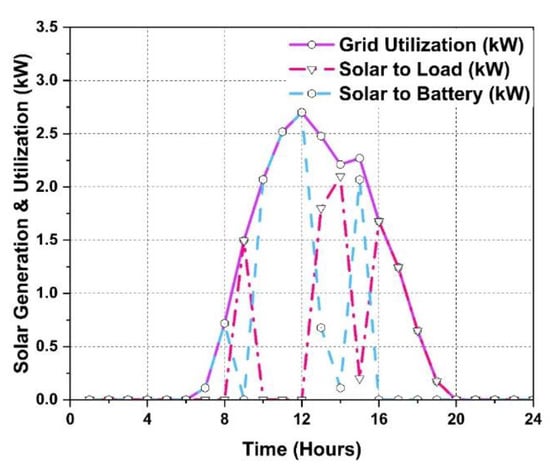
Figure 11.
Solar total generation and utilization (on−grid).
Load is directly fed through the EMS which decides the source path which needs to be triggered for the fulfillment of the load demand. A detailed analysis of total load and resource utilization in every hour is shown in Figure 12 for the on-grid model.

Figure 12.
Load demand and resource utilization (on−grid).
4.3. Main Findings of Grid Cost Analysis
The optimizer evaluated the cost charged by the grid for both models, and a cost comparison was made for one-day, monthly, and yearly basis after optimization of off-grid and on-grid models.
4.3.1. One-Day Grid Costing Profile
For the off-grid model, the optimizer evaluated the cost charged by the grid of a day as PKR 677.08 of household load as shown in Figure 13. During on-peak timing when grid cost is higher, the part of energy shared by the grid is very low, and in off-peak timing, the grid utilization is higher keeping in view the low cost of the grid. Meanwhile, in the on-grid model, with the same load and solar generation, the optimizer-generated cost of a day is PKR 467.08 as shown in Figure 14.
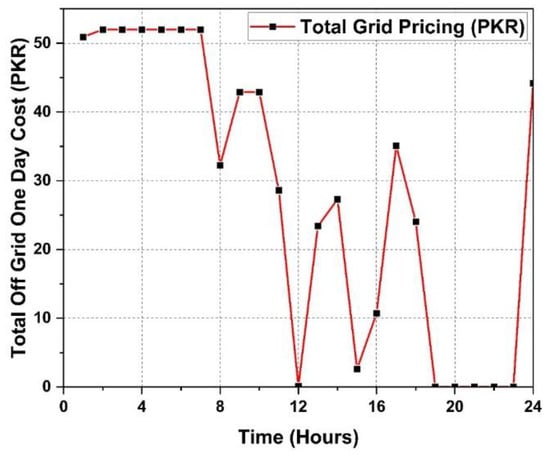
Figure 13.
Off−grid costing for one day.
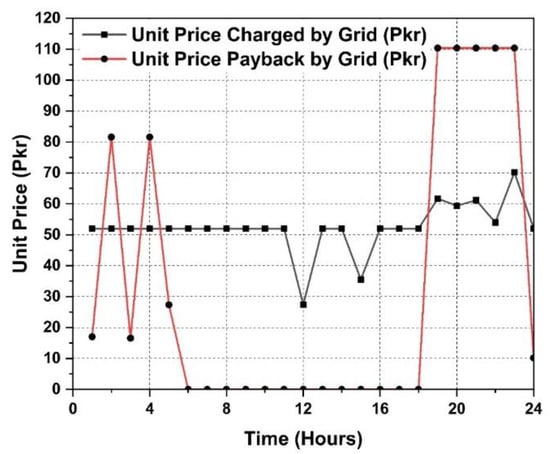
Figure 14.
On−grid costing for one day.
Grid intake cost = PKR 1253.4;
Grid payback cost = PKR 786.3238;
Total on-grid model cost = Grid intake cost-Grid payback cost = PKR 467.08.
4.3.2. Month-Wise Grid Costing Profile
The load and solar data of the complete year profile for analysis started in June 2018 and ended in May 2019. Month-wise billing and seasonal impacts on the bills are clearly understandable in Figure 15 and Figure 16 for the off-grid and on-grid models, respectively.
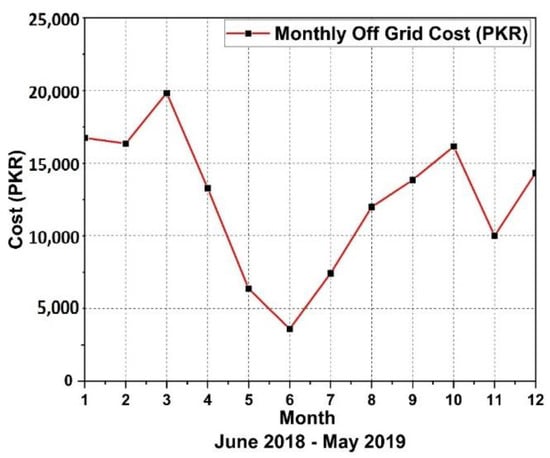
Figure 15.
Monthly off−grid model costing.
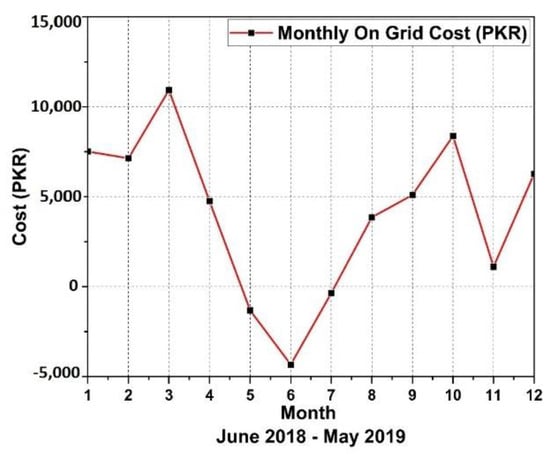
Figure 16.
Monthly on−grid model costing.
4.3.3. Findings for the Comparative Month-Wise Grid Costing
The cost of each day is calculated in both models, and the difference is very clear that the on-grid modeling approach is much more suitable for customers, and no compromise or sacrifice is made by the end-user. Monthly billing and the total annual saving plan are shown in Table 4 which shows the lower and optimized cost for the on-grid model throughout the year. Meanwhile, monthly bills compared on the grid and off the grid are shown in Figure 17.

Table 4.
Month-wise costing comparative analysis.
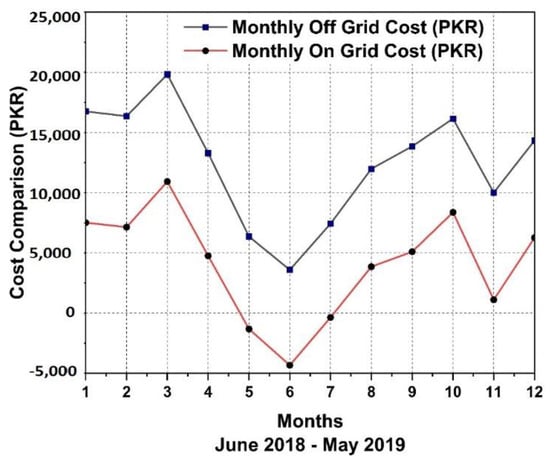
Figure 17.
Monthly grid costing comparative of a complete year.
Figure 17 indicates that the proposed scheme results in an optimized and low cost for the on-grid model throughout the year, and it is an optimum strategy for the implementation of residential microgrids. For instance, grid costing for the month of Jun-18 is PKR 16,755 by using the off-grid model, whereas the on-grid model costing is PKR 7511 only for the same month with the same load profile. Overall, the results specify that the daily average saving is about 32.0% by using the proposed on-grid scheme, where an FiT does exist.
5. Conclusions
A cost-effective microgrid-based energy management system was designed for off-grid and on-grid schemes integrated with solar PV generation and batteries. Linear programming (LP)-based optimization was utilized to formulate the off-grid and on-grid models for the cost analysis on a daily, monthly, and annual basis. One year of real-time load data was extracted from residential load, and solar data were taken from the NREL site of the subjected residential area. The state of charge (SoC) of the battery bank is controlled by allowable limits in the proposed model to maintain the battery’s health. The obtained results of grid costing in the proposed models for on-grid and off-grid consumers for the same load were compared for a better understanding of the revenue saving by using on-grid modeling. Grid cost calculations of the whole year with the same model on real-time load data were carried out for comparative analysis. These schemes are effective for the island as well as grid-connected modes. A quantitative framework analysis was carried out in which the simulation results clearly describe the battery efficient utilization and support in minimization of grid cost via on-grid modeling.
6. Limitations and Future Work
The proposed work only considered the baseline parameters common for residential, commercial, and industrial building microgrids. However, industrial and commercial microgrids may offer an additional layer of complexity that may be included in the additional layer of optimization; for instance, the efficiency of the battery can be included in the charging and discharging constraints for accurate energy balance. For future work, online optimization can be taken into account for updating the load values in real-time and feeding to the optimizer for efficient and scheduled usage of the grid. It will classify the users according to their energy sharing plan and cost-saving strategy that will ultimately result in a low cost of operation. Extensive research work on hardware using PLC and SCADA as discussed in [33,34] for implementation purposes is required in this field to implement the EMS in every residence and industry. Moreover, the solar output may vary based on the incident irradiance and weather conditions, while the current scheme relies on deterministic off-line data; therefore, for accurate estimations, the stochastic solar output can be used for future extensions of the proposed scheme. Lastly, in larger power networks where distribution is challenging, temporal network constraints need to be considered to avoid congestions and avoidance of voltage sags/swells.
Author Contributions
M.B.N. proposed the idea, performed mathematical modeling, performed the optimization and simulation analysis, and wrote the manuscript. M.N. provided technical support in MATLAB. A.H. supervised the research throughout. K.A.K.N. reviewed the paper. All authors have read and agreed to the published version of the manuscript.
Funding
This research received no external funding.
Institutional Review Board Statement
Not applicable.
Informed Consent Statement
Not applicable.
Data Availability Statement
Not applicable.
Conflicts of Interest
The authors declare no conflict of interest.
Nomenclature
| Acronyms | |
| HEMS | Home energy management system |
| BEMS | Building energy management system |
| LP | Linear programming |
| DR | Demand response |
| DRL | Deep reinforcement learning |
| TRPO | Trust region policy optimization |
| MDP | Markov decision process |
| DER | Distributed energy resources |
| ESS | Energy storage system |
| RES | Renewable energy resource |
| MPPT | Maximum power point tracking |
| PAR | Peak-to-average ratio |
| MACS | Multi-agent control system |
| HEMCS | Home energy management control system |
| FiT | Feed-in tariff |
| SoC | State of charge |
| NREL | National Renewable Energy Laboratory |
| MG | Microgrid |
| Variables | |
| t | Index for time |
| Grid to load | |
| Solar to load | |
| Solar to battery | |
| Battery to load | |
| Battery to grid | |
| Grid to battery | |
| Battery charging state | |
| Maximum value of available grid capacity | |
| Solar available at time t | |
| Solar maximum available capacity | |
| Battery maximum capacity | |
| Battery minimum state of charge | |
| at | Load |
| Next state of charge of battery | |
| eini | Battery initial state when day starts |
| efin | Battery final state when day ends |
| P(t) | Unit price charged by grid at time t |
| Unit price offered by grid at time | |
References
- Why Buildings Are the Foundation of an Energy-Efficient Future. Available online: https://www.weforum.org/agenda/2021/02/why-the-buildings-of-the-future-are-key-to-an-efficient-energy-ecosystem/ (accessed on 24 May 2022).
- Shareef, H.; Ahmed, M.S.; Mohamed, A.; Al Hassan, E. Review on Home Energy Management System Considering Demand Responses, Smart Technologies, and Intelligent Controllers. IEEE Access 2018, 6, 24498–24509. [Google Scholar] [CrossRef]
- Pipattanasomporn, M.; Kuzlu, M.; Rahman, S. An Algorithm for Intelligent Home Energy Management and Demand Response Analysis. IEEE Trans. Smart Grid 2012, 3, 2166–2173. [Google Scholar] [CrossRef]
- Li, H.; Wan, Z.; He, H. Real-Time Residential Demand Response. IEEE Trans. Smart Grid 2020, 11, 4144–4154. [Google Scholar] [CrossRef]
- Pedrasa, M.A.A.; Spooner, T.D.; MacGill, I.F. Coordinated scheduling of residential distributed energy re-sources to optimize smart home energy services. IEEE Trans. Smart Grid 2010, 1, 134–143. [Google Scholar]
- Guan, X.; Xu, Z.; Jia, Q.-S. Energy-Efficient Buildings Facilitated by Microgrid. IEEE Trans. Smart Grid 2010, 1, 243–252. [Google Scholar] [CrossRef]
- Lee, S.; Kwon, B.; Lee, S. Joint Energy Management System of Electric Supply and Demand in Houses and Buildings. IEEE Trans. Power Syst. 2014, 29, 2804–2812. [Google Scholar] [CrossRef]
- Ali, S.; Zheng, Z.; Aillerie, M.; Sawicki, J.P.; Pera, M.C.; Hissel, D. A review of DC microgrid energy management systems dedicated to residential applications. Energies 2021, 14, 4308. [Google Scholar]
- Luna, A.C.; Meng, L.; Diaz, N.L.; Graells, M.; Vasquez, J.C.; Guerrero, J.M. Online Energy Management Systems for Microgrids: Experimental Validation and Assessment Framework. IEEE Trans. Power Electron. 2017, 33, 2201–2215. [Google Scholar] [CrossRef]
- Azimian, M.; Amir, V.; Habibifar, R.; Golmohamadi, H. Probabilistic Optimization of Networked Multi-Carrier Microgrids to Enhance Resilience Leveraging Demand Response Programs. Sustainability 2021, 13, 5792. [Google Scholar] [CrossRef]
- Meng, L.; Sanseverino, E.R.; Luna, A.; Dragicevic, T.; Vasquez, J.C.; Guerrero, J.M. Mi-crogrid supervisory controllers and energy management systems: A literature review. Renew. Sustain. Energy Rev. 2016, 60, 1263–1273. [Google Scholar]
- Teimourzadeh Baboli, P.; Shahparasti, M.; Parsa Moghaddam, M.; Haghifam, M.R.; Mohamadian, M. Energy management and operation modelling of hybrid AC–DC microgrid. IET Gener. Transm. Distrib. 2014, 8, 1700–1711. [Google Scholar] [CrossRef]
- Kakigano, H.; Miura, Y.; Ise, T. Distribution Voltage Control for DC Microgrids Using Fuzzy Control and Gain-Scheduling Technique. IEEE Trans. Power Electron. 2012, 28, 2246–2258. [Google Scholar] [CrossRef]
- Li, C.; De Bosio, F.; Chen, F.; Chaudhary, S.K.; Vasquez, J.C.; Guerrero, J.M. Economic dispatch for operating cost minimization under real-time pricing in droop-controlled DC microgrid. IEEE J. Emerg. Sel. Top. Power Electron. 2016, 5, 587–595. [Google Scholar] [CrossRef] [Green Version]
- Chen, C.; Duan, S.; Cai, T.; Liu, B.; Hu, G. Smart energy management system for optimal mi-crogrid economic operation. IET Renew. Power Gener. 2011, 5, 258–267. [Google Scholar] [CrossRef]
- Chen, Y.; Jia, K.; Liu, B.; Yan, G.; Wang, D.; Li, C. Energy management method applying in integrated energy system. In Proceedings of the 5th International Conference on Electric Utility Deregulation and Restructuring and Power Technologies (DRPT), Changsha, China, 26–29 November 2015; pp. 1565–1569. [Google Scholar]
- Oriti, G.; Julian, A.L.; Peck, N.J. Power-electronics-based energy management system with storage. IEEE Trans. Power Electron. 2015, 31, 452–460. [Google Scholar] [CrossRef]
- Chen, Y.-K.; Wu, Y.-C.; Song, C.-C.; Chen, Y.-S. Design and Implementation of Energy Management System with Fuzzy Control for DC Microgrid Systems. IEEE Trans. Power Electron. 2012, 28, 1563–1570. [Google Scholar] [CrossRef]
- Barklund, E.; Pogaku, N.; Prodanovic, M.; Hernandez-Aramburo, C.; Green, T.C. Energy management in au-tonomous microgrid using stability-constrained droop control of inverters. IEEE Trans. Power Electron. 2008, 23, 2346–2352. [Google Scholar] [CrossRef]
- Pourmousavi, S.A.; Nehrir, M.H.; Colson, C.M.; Wang, C. Real-Time Energy Management of a Stand-Alone Hybrid Wind-Microturbine Energy System Using Particle Swarm Optimization. IEEE Trans. Sustain. Energy 2010, 1, 193–201. [Google Scholar] [CrossRef]
- Merabet, A.; Ahmed, K.T.; Ibrahim, H.; Beguenane, R.; Ghias, A.M.Y.M. Energy Management and Control System for Laboratory Scale Microgrid Based Wind-PV-Battery. IEEE Trans. Sustain. Energy 2016, 8, 145–154. [Google Scholar] [CrossRef]
- Byeon, G.; Yoon, T.; Oh, S.; Jang, G. Energy Management Strategy of the DC Distribution System in Buildings Using the EV Service Model. IEEE Trans. Power Electron. 2012, 28, 1544–1554. [Google Scholar] [CrossRef]
- Nejabatkhah, F.; Li, Y.W. Overview of Power Management Strategies of Hybrid AC/DC Microgrid. IEEE Trans. Power Electron. 2014, 30, 7072–7089. [Google Scholar] [CrossRef]
- Luna, A.C.; Diaz, N.L.; Graells, M.; Vasquez, J.C.; Guerrero, J.M. Mixed-integer-linear-programming-based energy management system for hybrid PV-wind-battery microgrids: Modeling, de-sign, and experimental verification. IEEE Trans. Power Electron. 2016, 32, 2769–2783. [Google Scholar] [CrossRef]
- Javaid, N.; Hafeez, G.; Iqbal, S.; Alrajeh, N.; Alabed, M.S.; Guizani, M. Energy Efficient Integration of Renewable Energy Sources in the Smart Grid for Demand Side Management. IEEE Access 2018, 6, 77077–77096. [Google Scholar] [CrossRef]
- Zhao, Z.; Lee, W.C.; Shin, Y.; Song, K.-B. An Optimal Power Scheduling Method for Demand Response in Home Energy Management System. IEEE Trans. Smart Grid 2013, 4, 1391–1400. [Google Scholar] [CrossRef]
- Wang, L.; Wang, Z.; Yang, R. Intelligent Multiagent Control System for Energy and Comfort Management in Smart and Sustainable Buildings. IEEE Trans. Smart Grid 2012, 3, 605–617. [Google Scholar] [CrossRef]
- Nasir, M.; Khan, H.A.; Khan, I.; Hassan, N.U.; Zaffar, N.A.; Mehmood, A.; Sauter, T.; Muyeen, S.M. Grid Load Reduction through Optimized PV Power Utilization in Intermittent Grids Using a Low-Cost Hardware Platform. Energies 2019, 12, 1764. [Google Scholar] [CrossRef]
- Hart, E.K.; Jacobson, M.Z. A Monte Carlo approach to generator portfolio planning and carbon emissions assessments of systems with large penetrations of variable renewables. Renew. Energy 2011, 36, 22782286. [Google Scholar] [CrossRef]
- Rahim, S.; Javaid, N.; Ahmad, A.; Khan, S.A.; Khan, Z.A.; Alrajeh, N.; Qasim, U. Exploiting heuristic algorithms to efciently utilize energy management controllers with renewable energy sources. Energy Build. 2016, 129, 452470. [Google Scholar] [CrossRef]
- Manzoor, A.; Javaid, N.; Ullah, I.; Abdul, W.; Almogren, A.; Alamri, A. An Intelligent Hybrid Heuristic Scheme for Smart Metering based Demand Side Management in Smart Homes. Energies 2017, 10, 1258. [Google Scholar] [CrossRef]
- Lust, T.; Teghem, J. The multiobjective multidimensional knapsack problem: A survey and a new approach. Int. Trans. Oper. Res. 2012, 19, 495–520. [Google Scholar] [CrossRef]
- González, I.; Calderón, A.J.; Portalo, J.M. Innovative multi-layered architecture for heterogeneous auto-mation and monitoring systems: Application case of a photovoltaic smart microgrid. Sustainability 2021, 13, 2234. [Google Scholar] [CrossRef]
- Cintuglu, M.H.; Mohammed, O.A.; Akkaya, K.; Uluagac, A.S. A survey on smart grid cyber-physical system testbeds. IEEE Commun. Surv. Tutor. 2016, 19, 446–464. [Google Scholar] [CrossRef]
Publisher’s Note: MDPI stays neutral with regard to jurisdictional claims in published maps and institutional affiliations. |
© 2022 by the authors. Licensee MDPI, Basel, Switzerland. This article is an open access article distributed under the terms and conditions of the Creative Commons Attribution (CC BY) license (https://creativecommons.org/licenses/by/4.0/).